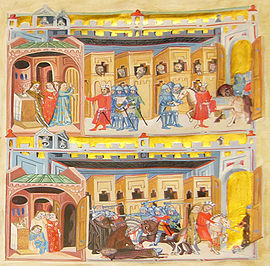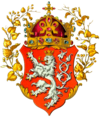Bretislav I
Bretislaus I, Duke of Bohemia | |
|---|---|
 Bretislaus I of Bohemia is kidnapping his future wife Judith of Schweinfurt from a monastery. From the Chronicle of Dalimil. | |
| Born | between 1002 and 1005 |
| Died | 10 January 1055 Chrudim |
| Noble family | Přemyslid dynasty |
| Spouse(s) | Judith of Schweinfurt |
| Issue | Spytihněv II, Duke of Bohemia Vratislaus II of Bohemia Conrad I, Duke of Bohemia Otto I of Olomouc |
| Father | Oldřich of Bohemia |
| Mother | Božena |
Bretislaus I (Czech: Břetislav I.) (1002/1005 – 10 January 1055), known as the Bohemian Achilles, of the house of the Přemyslids, was Duke of Bohemia from 1035 until his death.
Youth
Bretislaus was the son of Duke Oldřich[1] and his low-born concubine Božena. As an illegitimate son could not obtain a desirable wife by conventional means, he chose to kidnap his future wife Judith of Schweinfurt (Czech: Jitka), a daughter of the Bavarian noble Henry of Schweinfurt, Margrave of Nordgau, in 1019 at Schweinfurt.
During his father’s reign, in 1019 or 1029,[2] Bretislaus took back Moravia from Poland. About 1031 he invaded Hungary in order to prevent its expansion under king Stephen. The partition of Bohemia between Oldřich and his brother Jaromír in 1034 was probably the reason why Bretislaus fled beyond the Bohemian border, only to come back to take the throne after Jaromír’s abdication.
Raid into Poland
In 1035 Bretislaus helped Emperor Conrad II in his war against the Lusatians. In 1039 he invaded Little and Great Poland, captured Poznań and sacked Gniezno, bringing the relics of St. Adalbert, Radim Gaudentius and the Five Brothers back with him. On the way back he conquered part of Silesia including Wrocław (Czech: Vratislav). His main goal was to set up an archbishopric in Prague and create a large state subject only to the Holy Roman Empire. His raid had an unintended enduring influence on Polish history, as the plundering and destruction of Gniezno pushed the next Polish rulers to move their capital to Kraków, which would retain this role for many centuries ahead.
In 1040 the German King Henry III invaded Bohemia, but was forced to retreat after he lost the battle at Brůdek (a pass in the Bohemian Forest). The following year Henry III invaded again, skirted the border defences and laid siege to Bretislaus in Prague. Forced by a mutiny among his nobles and betrayed by his bishop, Bretislaus had to renounce all of his conquests save for Moravia and recognize Henry III as his sovereign.[1]
In 1047, Emperor Henry III negotiated a peace treaty between Bretislaus and the Poles. This pact worked in Bretislaus' favour, as the Polish ruler swore never again to attack Bohemia in return for an annual subsidy to Gniezno.
Domestic policy
Bretislaus was the author of decrees concerning the rules of Christianization, which included a ban on polygamy and trade on holidays.
It was in 1030 that Bretislaus married the afore-mentioned Judith. Before his death, Bretislaus organised the succession (in 1054) and issued the famous Seniority Law, introducing agnatic seniority for order of succession. Younger members of the dynasty were supposed to govern fiefs (technically, parts of Moravia), but only at the Duke's discretion. Result of this institution was relative indivisibility of the Czech lands, but also alternation of rules of stronger (or perhaps more political) dukes with periods of bitter fraction wars of members of the dynasty. It was effectively ended by elevation of Bohemia to kingdom under Ottokar I of Bohemia, when primogeniture became the ruling principle.
His eldest son Spytihněv was to succeed him as Duke of Bohemia with control over that territory. Moravia was incorporated into the Bohemian duchy, but divided between three of his younger sons. The Olomouc Appanage went to Vratislaus; the Znojmo Appanage went to Konrád; and the Brno Appanage went to Otto. The youngest son, Jaromír, entered the church and became Bishop of Prague.
Bretislaus died at Chrudim in 1055 during his preparation for another invasion of Hungary and was succeeded by his son Spytihněv II as Duke of Bohemia. His younger children were left the region of Moravia. Otto and Vratislav were shut out of the government by Spytihněv, but after his death both gained control of Moravia and Bohemia, respectively.
Ancestry
| Family of Bretislav I | |||||||||||||||||||||||||||||||||||||||||||||||||||||||||||||||||||||||||||||||||||||||||||||||||||||||||||||||||||||||||||||||||||||||||||||||||||||||||||||||||||||||||||||||||||||||||||||||||||||||||||||||||||||||||||||||||||||||||||||||||||||||||||||||||||||||||||||||||||||||||||||||||||||||||||||||||||||||||||||||||||||||||||||||||||||||||||||||||||||||||||||||||||||||||||||||||||||||||||||||||||||||||||||||||||||||||||||||||||||||||||||||||||||||||||||||||||
|---|---|---|---|---|---|---|---|---|---|---|---|---|---|---|---|---|---|---|---|---|---|---|---|---|---|---|---|---|---|---|---|---|---|---|---|---|---|---|---|---|---|---|---|---|---|---|---|---|---|---|---|---|---|---|---|---|---|---|---|---|---|---|---|---|---|---|---|---|---|---|---|---|---|---|---|---|---|---|---|---|---|---|---|---|---|---|---|---|---|---|---|---|---|---|---|---|---|---|---|---|---|---|---|---|---|---|---|---|---|---|---|---|---|---|---|---|---|---|---|---|---|---|---|---|---|---|---|---|---|---|---|---|---|---|---|---|---|---|---|---|---|---|---|---|---|---|---|---|---|---|---|---|---|---|---|---|---|---|---|---|---|---|---|---|---|---|---|---|---|---|---|---|---|---|---|---|---|---|---|---|---|---|---|---|---|---|---|---|---|---|---|---|---|---|---|---|---|---|---|---|---|---|---|---|---|---|---|---|---|---|---|---|---|---|---|---|---|---|---|---|---|---|---|---|---|---|---|---|---|---|---|---|---|---|---|---|---|---|---|---|---|---|---|---|---|---|---|---|---|---|---|---|---|---|---|---|---|---|---|---|---|---|---|---|---|---|---|---|---|---|---|---|---|---|---|---|---|---|---|---|---|---|---|---|---|---|---|---|---|---|---|---|---|---|---|---|---|---|---|---|---|---|---|---|---|---|---|---|---|---|---|---|---|---|---|---|---|---|---|---|---|---|---|---|---|---|---|---|---|---|---|---|---|---|---|---|---|---|---|---|---|---|---|---|---|---|---|---|---|---|---|---|---|---|---|---|---|---|---|---|---|---|---|---|---|---|---|---|---|---|---|---|---|---|---|---|---|---|---|---|---|---|---|---|---|---|---|---|---|---|---|---|---|---|---|---|---|---|---|---|---|---|---|---|---|---|---|---|---|---|---|---|---|---|---|---|---|---|---|---|---|---|---|---|---|---|---|---|---|---|---|---|---|---|---|---|---|---|---|---|---|---|---|---|---|---|---|---|---|---|---|---|---|---|---|---|---|---|---|---|---|---|---|---|---|---|---|
| |||||||||||||||||||||||||||||||||||||||||||||||||||||||||||||||||||||||||||||||||||||||||||||||||||||||||||||||||||||||||||||||||||||||||||||||||||||||||||||||||||||||||||||||||||||||||||||||||||||||||||||||||||||||||||||||||||||||||||||||||||||||||||||||||||||||||||||||||||||||||||||||||||||||||||||||||||||||||||||||||||||||||||||||||||||||||||||||||||||||||||||||||||||||||||||||||||||||||||||||||||||||||||||||||||||||||||||||||||||||||||||||||||||||||||||||||||
Notes
- ^ a b Bohemia to the Extinction of the Premyslids, Kamil Krofta, Cambridge Medieval History:Victory of the Papacy, Vol. VI, ed. J.R. Tanner, C.W. Previte-Orton and Z.N. Brooke, (Cambridge University Press, 1957), 426.
- ^ The exact date of the conquest of Moravia is unknown; Czech (and some Slovak) historians assert the earlier date, while their German and Polish colleagues recognize the latter one
References
- Krzemieńska, Barbara (1999). Břetislav I.: Čechy a střední Evropa v prvé polovině XI. století (in Czech) (2nd. ed.). Praha: Garamond. ISBN 80-901760-7-0.
{{cite book}}: Cite has empty unknown parameters:|month=and|coauthors=(help); Unknown parameter|trans_title=ignored (|trans-title=suggested) (help)

